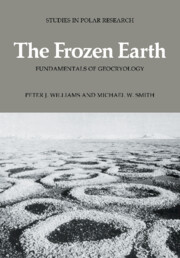Book contents
- Frontmatter
- Contents
- Symbols
- Preface
- Acknowledgements
- 1 PERIGLACIAL CONDITIONS
- 2 MORPHOLOGY OF PERMAFROST AND SEASONALLY FROZEN GROUND
- 3 CLIMATE AND FROZEN GROUND
- 4 THE GROUND THERMAL REGIME
- 5 THE FORMS OF THE GROUND SURFACE 1: SLOPES AND SUBSIDENCES
- 6 THE FORMS OF THE GROUND SURFACE 2: STRUCTURES AND MICROTOPOGRAPHY OF LEVEL GROUND
- 7 THERMODYNAMIC BEHAVIOUR OF FROZEN SOILS
- 8 HYDROLOGY OF FROZEN GROUND
- 9 THE MECHANICS OF FROZEN GROUND
- 10 GEOCRYOLOGY PAST AND FUTURE
- References
- Index
4 - THE GROUND THERMAL REGIME
Published online by Cambridge University Press: 24 October 2009
- Frontmatter
- Contents
- Symbols
- Preface
- Acknowledgements
- 1 PERIGLACIAL CONDITIONS
- 2 MORPHOLOGY OF PERMAFROST AND SEASONALLY FROZEN GROUND
- 3 CLIMATE AND FROZEN GROUND
- 4 THE GROUND THERMAL REGIME
- 5 THE FORMS OF THE GROUND SURFACE 1: SLOPES AND SUBSIDENCES
- 6 THE FORMS OF THE GROUND SURFACE 2: STRUCTURES AND MICROTOPOGRAPHY OF LEVEL GROUND
- 7 THERMODYNAMIC BEHAVIOUR OF FROZEN SOILS
- 8 HYDROLOGY OF FROZEN GROUND
- 9 THE MECHANICS OF FROZEN GROUND
- 10 GEOCRYOLOGY PAST AND FUTURE
- References
- Index
Summary
Introduction
The previous chapter discussed how the surface temperature is governed by climatic and microclimatic conditions. In turn, the surface regime is the major factor affecting the ground thermal regime. Once the surface temperature regime is known, the thermal regime of the ground may generally be analysed without further reference to climate. However, ground thermal properties and, at greater depths, the heat flowing from the earth's interior, serve to modify the effects of surface temperature (Figure 3.4).
The behaviour of soils in cold regions is strongly influenced by temperature and therefore the analysis of ground thermal regimes is of importance in many problems of scientific interest. In addition, the thermal interaction of engineering structures with frozen ground must be understood to allow for their proper design. While cold is generally seen as the singular feature of high latitudes, it is often the problems resulting from thaw that are of vital concern to engineering design. The problem of thaw settlement is not purely thermal, however. When soils thaw, meltwater is produced at a rate controlled by thermal processes, whereas the dissipation of this water depends on the discharge capacity of the soil (e.g. Nixon & Ladanyi, 1978).
Ground temperatures are, for the most part, determined by conductive heat transfer, although localised circulation of groundwater can occur particularly in areas of seasonal frost and discontinuous permafrost. In general, therefore, ground temperatures can be analysed in terms of heat conduction theory.
- Type
- Chapter
- Information
- The Frozen EarthFundamentals of Geocryology, pp. 83 - 121Publisher: Cambridge University PressPrint publication year: 1989
- 2
- Cited by



